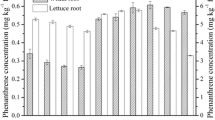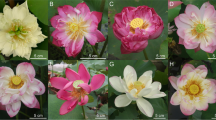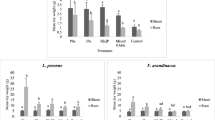Abstract
Polycyclic aromatic hydrocarbons (PAHs), as priority organic pollutants, are capable of accumulation in plants. Phenanthrene (Phe) is one of the most abundant low-molecular-weight PAH in the environment which is commonly used as a model PAH in many phytoremediation studies and as a representative compound for all PAHs group. This paper highlights the uptake, translocation, and accumulation of Phe by growing proso millet (Panicum miliaceum L.) in a pot experiment, subjected to 500, 1000, 1500, and 2000 ppm of Phe treatment after 15 and 30 days. Phe naturally existed in P. miliaceum and its concentration showed a time-dependent reduction in treated plant tissues as well as in perlites. Phe concentration in shoots was higher than in roots. During the aging process, the uptake of Phe was diminished whereas translocation factor (TF) demonstrated an overall increasing trend among treatments. The shoot concentration factor (SCF) values were higher than those of root concentration factor (RCF) on both days 15 and 30 and the highest values for both parameters were achieved in 500 ppm of Phe. Both RCFs and SCFs generally tended to decrease with the increase of perlite Phe concentrations. These results suggested that Phe tended to transfer to the shoots and be metabolized there. The Phe concentration revealed a significant decline in all levels of treatment on both 15 (84 to 96%) and 30 (76 to 94%) days. Therefore, the presence of P. miliaceum was effective in promoting the phytoremediation of Phe polluted perlites.




Similar content being viewed by others

References
Abdel-Shafy, H. I., & Mansour, M. S. (2016). A review on polycyclic aromatic hydrocarbons: Source, environmental impact, effect on human health and remediation. Egyptian Journal of Petroleum, 25(1), 107–123. https://doi.org/10.1016/j.ejpe.2015.03.011
Ahmed, A., Ohlson, M., Hoque, S., & Moula, M. G. (2010). Chemical composition of leaves of a mangrove tree (Sonneratia apetala Buch.-Ham.) and their correlation with some soil variables. Bangladesh Journal of Botany, 39(1), 61–69. https://doi.org/10.3329/bjb.v39i1.5528
Aleman, F., Nieves-Cordones, M., Martínez, V., & Rubio, F. (2009). Potassium/sodium steady-state homeostasis in Thellungiella halophila and Arabidopsis thaliana under long-term salinity conditions. Plant Science, 176(6), 768–774. https://doi.org/10.1016/j.plantsci.2009.02.020
Belykh, L. I. (2009). Distribution of polycyclic aromatic hydrocarbons in the soil–plant system. Eurasian Soil Science, 42(9), 1005–1011. https://doi.org/10.1134/s1064229309090075
Borneff, F., Farkasdi, G., Glathe, H., & Kunte, H. (1973). The fate of polycyclic aromatic hydrocarbons in experiments using sewage sludge-garbage composts as fertilizers. Zentralblatt fur Bakteriologie, Parasitenkunde, Infektionskrankheiten und Hygiene. Erste Abteilung Originale. Reihe B: Hygiene, praventive Medizin, 157(2), 151–164.
Briggs, G. G., Bromilow, R. H., Evans, A. A., & Williams, M. (1983). Relationships between lipophilicity and the distribution of non-ionised chemicals in barley shoots following uptake by the roots. Pesticide Science, 14(5), 492–500. https://doi.org/10.1002/ps.2780140506
Chen, Z. X., Ni, H. G., Jing, X., Chang, W. J., Sun, J. L., & Zeng, H. (2015). Plant uptake, translocation, and return of polycyclic aromatic hydrocarbons via fine root branch orders in a subtropical forest ecosystem. Chemosphere, 131, 192–200. https://doi.org/10.1016/j.chemosphere.2015.03.045
Desalme, D., Binet, P., & Chiapusio, G. (2013). Challenges in tracing the fate and effects of atmospheric polycyclic aromatic hydrocarbon deposition in vascular plants. Environmental Science & Technology, 47(9), 3967–3981. https://doi.org/10.1021/es304964b
Dettenmaier, E. M., Doucette, W. J., & Bugbee, B. (2009). Chemical hydrophobicity and uptake by plant roots. Environmental Science & Technology, 43(2), 324–329. https://doi.org/10.1021/es801751x
Fletcher, J. S., McFarlane, J. C., Pfleeger, T., & Wickliff, C. (1990). Influence of root exposure concentration on the fate of nitrobenzene in soybean. Chemosphere, 20(5), 513–523. https://doi.org/10.1016/0045-6535(90)90108-6
Gao, Y., & Collins, C. D. (2009). Uptake pathways of polycyclic aromatic hydrocarbons in white clover. Environmental Science & Technology, 43(16), 6190–6195. https://doi.org/10.1021/es900662d
Gao, Y., Ling, W., & Wong, M. H. (2006). Plant-accelerated dissipation of phenanthrene and pyrene from water in the presence of a nonionic-surfactant. Chemosphere, 63(9), 1560–1567. https://doi.org/10.1016/j.chemosphere.2005.09.058
Gao, Y., & Zhu, L. (2004). Plant uptake, accumulation and translocation of phenanthrene and pyrene in soils. Chemosphere, 55(9), 1169–1178. https://doi.org/10.1016/j.chemosphere.2004.01.037
García, R., Díaz-Somoano, M., Calvo, M., López-Antón, M. A., Suárez, S., Ruiz, I. S., & Martínez-Tarazona, M. R. (2012). Impact of a semi-industrial coke processing plant in the surrounding surface soil. Part II: PAH content. Fuel Processing Technology, 104, 245–252. https://doi.org/10.1016/j.fuproc.2012.05.018
Gregor, M. (2004). Metal availability, uptake, transport and accumulation in plants. In M. N. V. Prasad (Ed.), Heavy Metal Stress in Plants—From Biomolecules to Ecosystems (pp. 1–27). Spinger.
Houshani, M., Salehi-Lisar, S. Y., Motafakkerazad, R., & Movafeghi, A. (2019). Uptake and distribution of phenanthrene and pyrene in roots and shoots of maize (Zea mays L.). Environmental Science and Pollution Research, 26(10), 9938–9944. https://doi.org/10.1007/s11356-019-04371-3
Kang, F., Chen, D., Gao, Y., & Zhang, Y. (2010). Distribution of polycyclic aromatic hydrocarbons in subcellular root tissues of ryegrass (Lolium multiflorum Lam.). BMC Plant Biology, 10(1), 1–7. https://doi.org/10.1186/1471-2229-10-210
Khan, S., Aijun, L., Zhang, S., Hu, Q., & Zhu, Y. G. (2008). Accumulation of polycyclic aromatic hydrocarbons and heavy metals in lettuce grown in the soils contaminated with long-term wastewater irrigation. Journal of Hazardous Materials, 152(2), 506–515. https://doi.org/10.1016/j.jhazmat.2007.07.014
Kipopoulou, A., Manoli, E., & Samara, C. (1999). Bioconcentration of polycyclic aromatic hydrocarbons in vegetables grown in an industrial area. Environmental Pollution, 106(3), 369–380. https://doi.org/10.1016/s0269-7491(99)00107-4
Kummerová, M., Zezulka, Š, Váňová, L., & Fišerová, H. (2012). Effect of organic pollutant treatment on the growth of pea and maize seedlings. Open Life Sciences, 7(1), 159–166.
Kvesitadze, G., Khatisashvili, G., Sadunishvili, T., & Kvesitadze, E. (2015). Plants for remediation: Uptake, translocation and transformation of organic pollutants. In M. Öztürk, M. Ashraf, A. Aksoy, M. S. A. Ahmad, & K. R. Hakeem (Eds.), Plants, pollutants and remediation (pp. 241–308). Springer. https://doi.org/10.1007/978-94-017-7194-8_12
Li, F., Zeng, X., Yang, J., Zhou, K., Zan, Q., Lei, A., & Tam, N. F. (2014). Contamination of polycyclic aromatic hydrocarbons (PAHs) in surface sediments and plants of mangrove swamps in Shenzhen, China. Marine Pollution Bulletin, 85(2), 590–596. https://doi.org/10.1016/j.marpolbul.2014.02.025
Li, H., Sheng, G., Sheng, W., & Xu, O. (2002). Uptake of trifluralin and lindane from water by ryegrass. Chemosphere, 48(3), 335–341. https://doi.org/10.1016/s0045-6535(02)00093-0
Li, Z., Wang, W., & Zhu, L. (2020). A three-phase-successive partition-limited model to predict plant accumulation of organic contaminants from soils treated with surfactants. Environmental Pollution, 261, 114071. https://doi.org/10.1016/j.envpol.2020.114071
Limmer, M. A., & Burken, J. G. (2014). Plant translocation of organic compounds: Molecular and physicochemical predictors. Environmental Science & Technology Letters, 1(2), 156–161. https://doi.org/10.1021/ez400214q
Maurel, C. (1997). Aquaporins and water permeability of plant membranes. Annual Review of Plant Biology, 48(1), 399–429. https://doi.org/10.1146/annurev.arplant.48.1.399
McLachlan, M. S., & Horstmann, M. (1998). Forests as filters of airborne organic pollutants: A model. Environmental Science & Technology, 32(3), 413–420. https://doi.org/10.1021/es970592u
Melo, E. E. C., Costa, E. T. S., Guilherme, L. R. G., Faquin, V., & Nascimento, C. W. A. (2009). Accumulation of arsenic and nutrients by castor bean plants grown on an As-enriched nutrient solution. Journal of Hazardous Materials, 168(1), 479–483. https://doi.org/10.1016/j.jhazmat.2009.02.048
Mueller, K. E., & Shann, J. R. (2006). PAH dissipation in spiked soil: Impacts of bioavailability, microbial activity, and trees. Chemosphere, 64(6), 1006–1014. https://doi.org/10.1016/j.chemosphere.2005.12.051
Naidoo, G., & Naidoo, K. (2016). Uptake of polycyclic aromatic hydrocarbons and their cellular effects in the mangrove Bruguiera gymnorrhiza. Marine Pollution Bulletin, 113(1–2), 193–199. https://doi.org/10.1016/j.marpolbul.2016.09.012
Nam, K., & Kim, J. Y. (2002). Role of loosely bound humic substances and humin in the bioavailability of phenanthrene aged in soil. Environmental Pollution, 118(3), 427–433. https://doi.org/10.1016/s0269-7491(01)00296-2
Parrish, Z. D., White, J. C., Isleyen, M., Gent, M. P., Iannucci-Berger, W., Eitzer, B. D., Kelsey, J. W., & Mattina, M. I. (2006). Accumulation of weathered polycyclic aromatic hydrocarbons (PAHs) by plant and earthworm species. Chemosphere, 64(4), 609–618. https://doi.org/10.1016/j.chemosphere.2005.11.003
Ryan, J. A., Bell, R. M., Davidson, J. M., & O’connor, G. A. (1988). Plant uptake of non-ionic organic chemicals from soils. Chemosphere, 17(12), 2299–2323. https://doi.org/10.1016/0045-6535(88)90142-7
Samanta, S. K., Singh, O. V., & Jain, R. K. (2002). Polycyclic aromatic hydrocarbons: Environmental pollution and bioremediation. TRENDS in Biotechnology, 20(6), 243–248. https://doi.org/10.1016/s0167-7799(02)01943-1
Sitte, P., Ziegler, H., Ehrendorfer, F., & Bresinsky, A. (1991). Lehrbuch der Botanik für Hochschulen 33. Fischer.
Sobhani, A., Salehi-Lisar, S. Y., Motafakkerazad, R., & Movafeghi, A. (2020). Uptake and distribution of phenanthrene and pyrene in roots and shoots of wheat (Triticum aestivum L.). Polycyclic Aromatic Compounds, 42, 1–8. https://doi.org/10.1080/10406638.2020.1744166
Sojinu, O. S., Wang, J. Z., Sonibare, O. O., & Zeng, E. Y. (2010). Polycyclic aromatic hydrocarbons in sediments and soils from oil exploration areas of the Niger Delta, Nigeria. Journal of Hazardous Materials, 174(1–3), 641–647. https://doi.org/10.1016/j.jhazmat.2009.09.099
Somtrakoon, K., & Chouychai, W. (2013). Phytotoxicity of single and combined polycyclic aromatic hydrocarbons toward economic crops. Russian Journal of Plant Physiology, 60(1), 139–148. https://doi.org/10.1134/S1021443712060155
Sun, Y., & Zhou, Q. (2016). Uptake and translocation of benzo [a] pyrene (B [a] P) in two ornamental plants and dissipation in soil. Ecotoxicology and Environmental Safety, 124, 74–81. https://doi.org/10.1016/j.ecoenv.2015.09.037
Sun, Y., Zhou, Q., Xu, Y., Wang, L., & Liang, X. (2011). Phytoremediation for co-contaminated soils of benzo [a] pyrene (B [a] P) and heavy metals using ornamental plant Tagetes patula. Journal of Hazardous Materials, 186(2–3), 2075–2082. https://doi.org/10.1016/j.jhazmat.2010.12.116
Tao, S., Jiao, X. C., Chen, S. H., Liu, W. X., Coveney, R. M., Jr., Zhu, L. Z., & Luo, Y. M. (2006). Accumulation and distribution of polycyclic aromatic hydrocarbons in rice (Oryza sativa). Environmental Pollution, 140(3), 406–415. https://doi.org/10.1016/j.envpol.2005.08.004
Tarigholizadeh, S., Motafakkerazad, R., Salehi-Lisar, S. Y., & Kazemi, E. M. (2021). High resistance of Panicum miliaceum L. to phenanthrene toxicity based on growth response and antioxidant system assessment. Acta Agriculturae Slovenica, 117(2), 1–13. https://doi.org/10.14720/aas.2021.117.2.1987
Tian, L., Yin, S., Ma, Y., Kang, H., Zhang, X., Tan, H., Meng, H., & Liu, C. (2019). Impact factor assessment of the uptake and accumulation of polycyclic aromatic hydrocarbons by plant leaves: Morphological characteristics have the greatest impact. Science of the Total Environment, 652, 1149–1155. https://doi.org/10.1016/j.scitotenv.2018.10.357
Trapp, S., Matthies, M., Scheunert, I., & Topp, E. M. (1990). Modeling the bioconcentration of organic chemicals in plants. Environmental Science & Technology, 24(8), 1246–1252. https://doi.org/10.1021/es00078a013
Tyerman, S. D., Bohnert, H. J., Maurel, C., Steudle, E., & Smith, J. A. C. (1999). Plant aquaporins: Their molecular biology, biophysics and significance for plant water relations. Journal of Experimental Botany, 50, 1055–1071.
Vacha, R., Čechmánková, J., & Skála, J. (2010). Polycyclic aromatic hydrocarbons in soil and selected plants. Plant, Soil and Environment, 56(9), 434–443.
Wang, Y., Tian, Z., Zhu, H., Cheng, Z., Kang, M., Luo, C., Li, J., & Zhang, G. (2012). Polycyclic aromatic hydrocarbons (PAHs) in soils and vegetation near an e-waste recycling site in South China: Concentration, distribution, source, and risk assessment. Science of the Total Environment, 439, 187–193. https://doi.org/10.1016/j.scitotenv.2012.08.018
Wang, Y., Wang, S., Luo, C., Xu, Y., Pan, S., Li, J., Meng, L., Zhang, G., & Li, X. (2015). Influence of rice growth on the fate of polycyclic aromatic hydrocarbons in a subtropical paddy field: A life cycle study. Chemosphere, 119, 1233–1239. https://doi.org/10.1016/j.chemosphere.2014.09.104
Wild, E., Dent, J., Thomas, G. O., & Jones, K. C. (2005). Direct observation of organic contaminant uptake, storage, and metabolism within plant roots. Environmental science & technology, 39, 3695–3702. https://doi.org/10.1021/es048136a
Wild, E., Dent, J., Thomas, G. O., & Jones, K. C. (2006). Visualizing the air-to-leaf transfer and within-leaf movement and distribution of phenanthrene: Further studies utilizing two-photon excitation microscopy. Environmental Science & Technology, 40(3), 907–916. https://doi.org/10.1021/es0515046
Wild, S. R., & Jones, K. C. (1992). Organic chemicals entering agricultural soils in sewage sludges: Screening for their potential to transfer to crop plants and livestock. Science of the Total Environment, 119, 85–119. https://doi.org/10.1016/0048-9697(92)90258-t
Wiłkomirski, B., Jabbarov, Z. A., Abdrakhmanov, T. A., Vokhidova, M. B., Jabborov, B. T., Fakhrutdinova, M. F., Okolelov, A. A., Kholdorov, S., & Abdullayeva, Y. D. (2018). Polycyclic aromatic hydrocarbons (PAHs) in natural and anthropogenically modified soils (a review). Biogeosystem Technique, 5, 229–243.
Wu, X., & Zhu, L. (2019). Prediction of organic contaminant uptake by plants: Modified partition-limited model based on a sequential ultrasonic extraction procedure. Environmental Pollution, 246, 124–130. https://doi.org/10.1016/j.envpol.2018.11.066
Xu, S. Y., Chen, Y. X., Lin, Q., Wu, W. X., Xue, S. G., & Shen, C. F. (2005). Uptake and accumulation of phenanthrene and pyrene in spiked soils by Ryegrass (Lolium perenne L.). Journal of Environmental Sciences, 17(5), 817–822.
Yang, Y., Woodward, L. A., Li, Q. X., & Wang, J. (2014). Concentrations, source and risk assessment of polycyclic aromatic hydrocarbons in soils from Midway Atoll, North Pacific Ocean. PLoS ONE, 9(1), e86441. https://doi.org/10.1371/journal.pone.0086441
Zhan, X., Yi, X., Yue, L., Fan, X., Xu, G., & Xing, B. (2015). Cytoplasmic pH-stat during phenanthrene uptake by wheat roots: A mechanistic consideration. Environmental Science & Technology, 49(10), 6037–6044. https://doi.org/10.1021/acs.est.5b00697
Zhang, C., Yao, F. E. N. G., Liu, Y. W., Chang, H. Q., Li, Z. J., & Xue, J. M. (2017). Uptake and translocation of organic pollutants in plants: A review. Journal of Integrative Agriculture, 16(8), 1659–1668. https://doi.org/10.1016/s2095-3119(16)61590-3
Acknowledgements
The authors thank the Research Affairs of the University of Tabriz for financial and other supports.
Funding
The research was financially supported by the Ministry of Science and Higher Education of the Russian Federation project on the development of the Young Scientist Laboratory (no. LabNOTs-21-01AB). The research was supported by the Strategic Academic Leadership Program of the Southern Federal University (“Priority 2030”).
Author information
Authors and Affiliations
Contributions
ST: conceptualization, methodology, writing—original draft. RM: supervision, project administration, data curation, writing—review and editing. SYSL: data curation, visualization, investigation. EMK: investigation formal analysis. SS: data curation, validation, formal analysis. TM: writing—reviewing and editing, supervision.
Corresponding author
Ethics declarations
Conflict of interest
The authors declare that they have no conflicts of interest.
Additional information
Publisher's Note
Springer Nature remains neutral with regard to jurisdictional claims in published maps and institutional affiliations.
Rights and permissions
About this article
Cite this article
Tarigholizadeh, S., Motafakkerazad, R., Salehi-Lisar, S.Y. et al. Phenanthrene uptake and translocation by Panicum miliaceum L. tissues: an experimental study in an artificial environment. Environ Geochem Health 45, 9281–9292 (2023). https://doi.org/10.1007/s10653-022-01294-w
Received:
Accepted:
Published:
Issue Date:
DOI: https://doi.org/10.1007/s10653-022-01294-w



